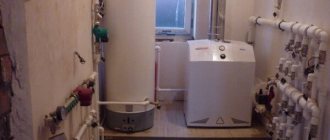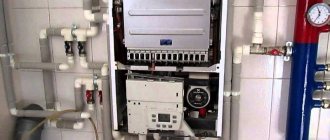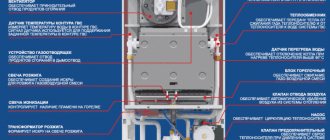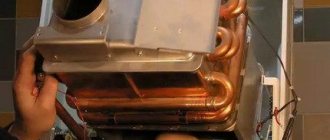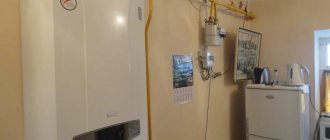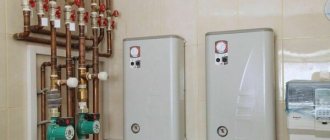Arranging an autonomous heating system requires a careful approach to the selection of all equipment. If the pipes are incorrectly selected, the coolant may circulate at an abnormal speed; a lack or excess of radiators will lead to poor heating or wasteful consumption of thermal energy. It is equally important to choose the right heating unit. If there is a gas main, the best choice is a gas parapet boiler. The model is distinguished by its small dimensions, ease of installation, ease of operation, maintainability and other advantages. Let's look at the features and characteristics of the product.
The need to use parapet boilers
Parapet boilers are one of the best options. They can even be used to heat a city apartment. Initially, such equipment was developed as an alternative to wall-mounted ones, which have many advantages, but are very demanding in terms of operating conditions. For stable operation, they need constant pressure, soft water, high quality gas, as well as an uninterrupted power supply. For this reason, such devices often fail and require regular maintenance. Over time, they were replaced by parapet boilers. They do not require such stringent operational requirements and are able to ensure stable operation of the heating system. The described installations are energy-dependent heating units, which are intended for installation in apartments and private houses, combining all the positive characteristics of convectors and gas boilers.
Design options
As noted above, double-circuit turbocharged gas boilers can be wall-mounted or floor-mounted. Let's take a closer look at their features.
Floor-standing gas boilers are characterized by high power, and gas consumption remains almost the same as that of less powerful wall-mounted ones. Most designs of floor-standing gas double-circuit boilers are equipped with a cast iron heat exchanger, which has a long service life as it is resistant to high temperatures and corrosive destruction.
The high heat capacity of cast iron allows you to maintain the required air temperature in the room with virtually no fluctuations.
Also, floor-standing boilers have a large water storage volume, therefore they provide more comfortable use of hot water in the hot water supply system when implementing a flow-through supply system.
The disadvantages include the rather large weight and high cost.
The design of a wall-mounted turbocharged heating boiler includes the following elements:
- Turbocharged burner;
- Circulation pump and expansion tank;
- Measuring automation.
The main difference from the floor version is the installation method. Mounted double-circuit gas boilers are fixed to the wall using anchor bolts.
The advantages of a wall-mounted gas boiler include:
- Compact size and light weight;
- The cost is approximately 2 times lower than that of the floor option;
- Ease of operation and inexpensive maintenance;
However, the disadvantage of a wall-mounted boiler, compared to a floor-standing one, is the use of a steel or copper heat exchanger, which quickly burns out and needs to be replaced.
Connection features
Parapet boilers have a closed combustion chamber that does not communicate with the room. The equipment is installed without emitting combustion products into the external environment. This is essential for oversized rooms that have a fairly weak ventilation system. For this reason, such equipment does not require the installation of a traditional chimney; only a side coaxial one, also called coaxial, will be sufficient. It is installed by first connecting two pipes that are located inside each other. To ensure the supply of fresh air to the combustion chamber, as well as the removal of combustion products to the outside, this element is required. Due to the fact that there are holes in the case, there is no need to install additional batteries in the rooms. One boiler will be enough to provide full heating. Parapet boilers are connected according to the same principle as is used in the case of convectors. This involves the use of pipes that are necessary to connect to the water supply and gas pipeline systems. This is true if the equipment is double-circuit; it is fixed to the wall surface using brackets.
Operating principle of an atmospheric boiler
An important difference between an atmospheric boiler and a turbocharged one is the type of burner. In the first model, it is a set of nozzles, the diameter of which is small enough to ensure gas exits at a certain pressure
It also regulates the amount of incoming oxygen, and, accordingly, the intensity of combustion.
All of the above factors can be considered either features or disadvantages of the equipment, depending on the specific situation, but atmospheric boilers have two important and undeniable advantages that often sway the consumer in their favor. First of all, this is the fact that most models of this type are non-volatile, and therefore preferable in operation in the presence of constant interruptions or unstable power supply. The second advantage is the low price (in comparison with turbocharged models of comparable power) of the equipment
It is important to note the safety of operation, for which the traction sensor is responsible, and which is equipped with almost all models of this type
Main advantages
If you decide to choose a Termotechnik parapet boiler for heating, you should first become familiar with its main positive features. Among them, we can highlight the fact that the equipment has a closed combustion chamber. For this reason, there is no need to install a full chimney. The boiler can be installed in any room in which one of the walls must be external. Full heating of the entire room is ensured by the presence of convection holes in the unit body. The use of additional radiators is not required for the reason that the boiler is both a battery and a furnace. The equipment can be installed in a city apartment; for this you only need electricity and a gas pipeline. If we are talking about an apartment, then the equipment is installed in the window sill, in the kitchen. As an alternative solution, you can install the boiler near the wall, but it will be necessary to create an external hole in it, which is necessary for the outlet of the coaxial chimney. An additional advantage is a fairly wide range of models, which allows consumers to choose the most optimal option for a room of any size. During the purchasing process, it is important to pay attention to the power, which can vary from 15 to 40 kW.
Considering the Termotechnik parapet boiler, one cannot help but note that among its positive features is also its versatility. The model range is represented by options that can have one or two circuits. In the case of two circuits, the unit will be able to not only heat the room, but also provide water heating, which is true in the absence of hot water supply. If you decide to equip an individual heating system, then the Aton parapet gas boiler will be a relatively affordable solution, which makes such equipment profitable. The case has a modern design, which does not spoil the overall appearance of the interior if you decide to install the equipment in the right place.
Features of equipment and manufactured models
Vulcan boilers are two lines of modern underfloor heating equipment for heating residential buildings and other buildings. Features and advantages of these units:
- Long service life - the average is at least 14 years.
- High efficiency – it is up to 92%.
- Stable operation in any conditions.
- Durable stainless steel burners.
- Complete energy independence.
- Open combustion chambers.
- Heated area – up to 300 sq. m.
In addition, Vulcan gas boilers are divided into parapet-type models and models with traditional chimneys.
The undoubted advantage of these boilers is the lack of dependence on the electrical network. Thanks to this, they will be able to work in populated areas where there is no gas supply. The presented models are made in a floor-standing form factor, they do not take up much space and have a good, albeit austere, appearance. Let's see what we can find on sale.
Gas boiler Vulcan AOGV 10 E
Before us is a typical model, made according to a single-circuit design using a traditional chimney. It is intended for use in heating systems with forced or natural circulation of water and other types of coolants. There is no second circuit; small-volume, connected “indirect” boilers are used to prepare hot water. In order not to create unnecessary load and not waste heat, you can install an electric storage water heater in your home.
The Vulcan AOGV 10 E boiler is connected to the gas mains, but can also operate on liquefied gas. The control system here is mechanical, with a similar protection system. The heat exchanger is made of steel with additional corrosion protection. The burner manufacturer is the Italian company Polidoro. The thermal power of the unit is 10 kW, gas consumption is up to 1.4 cubic meters. m/hour.
Gas boiler Vulcan AOGV 12 VE
This model is suitable for heating households and other buildings with an area of up to 120 square meters. m. Its power is 12 kW, so taking into account the required reserve, it is better to heat a maximum of 100 square meters. The boiler is built according to a two-circuit scheme, the switching is controlled by Italian automatics, as is customary in similar units from alternative brands. A traditional chimney is used to remove combustion products.
The boiler is connected to the gas main, consuming up to 1.56 cubic meters from it at maximum load. The efficiency is 90%, which is quite a high figure. The operating temperature of the coolant is from +50 to +90 degrees, the volume of boiler water is 19.3 liters.
Gas boiler Vulcan AOGV 9 VPE
Let's move on to parapet models. They differ from traditional Vulcan boilers in that they do not require traditional chimneys to operate. Instead, double pipe-in-pipe (coaxial) chimneys are used, exiting from the rear and extending behind the wall. The presented model is dual-circuit and non-volatile. It is suitable for installation in new households, where conventional chimneys are rarely built. The unit is no different in appearance from its counterparts with open combustion chambers.
The Vulcan AOGV 9 VPE boiler operates from a gas main with a maximum consumption of up to 1.4 cubic meters. m/hour. Its heat exchanger is made of durable steel, protected from corrosion by a special coating. Italian mechanical automation is responsible for controlling the temperature in the pipes and the second circuit. Ignition is carried out from a piezoelectric igniter. The boiler does not require connection to an outlet, and the two-way connection to the heating circuit ensures ease of installation.
Gas boiler Vulcan AOGV 16 VPE
Before us is one of the most powerful parapet-type boilers. It is equipped with a closed combustion chamber; the combustion products released by it are sent outside through a coaxial chimney. Through it, air is taken in for the burner to operate. The power of the device is 16 kW, which is enough to heat rooms up to 160 square meters. As in all other models, the heat exchanger here is made of steel, with additional treatment against corrosion.
The control system is mechanical, made in Italy. It provides switching between circuits and maintaining the set temperature in the heating system. Ignition is carried out by a piezoelectric igniter. Connection to the electrical network is not required, thanks to which the Vulcan AOGV 16 VPE boiler can be operated in buildings not connected to gas mains.
Cons of parapet boilers
If you decide to purchase an Aton parapet gas boiler, then you should consider the disadvantages of this equipment. Among them, it is worth highlighting their low power, which indicates the possibility of using them in small areas. Home craftsmen especially note the disadvantage, which is the need for help from specialists in the installation of a coaxial pipe.
What determines the price of the unit?
When consumers choose gas equipment, they focus primarily on its cost.
The price depends on several parameters:
- power;
- number of options;
- manufacturer brand reputation;
- Year of release;
- relevance of the model range.
For consumers, it is important to guarantee the reliability and safety of the device. Naturally, a boiler equipped with an automation system will cost more.
Sources
- https://teplospec.com/gazovoe-otoplenie/kak-ustroen-turbirovannyy-gazovyy-kotel-printsip-raboty-preimushchestva-i-nedostatki.html
- https://bouw.ru/article/gazoviy-kotel-dvuhkonturniy-turbirovanniy-nastenniy
- https://oteple.com/nastennyj-turbirovannyj-gazovyj-kotel/
- https://svoimi-rykami.ru/stroitelstvo-doma/pechi_i_mangaly/ventilyator-dlya-kotla-svoimi-rukami.html
Types of parapet boilers
If you decide to purchase a floor-mounted parapet boiler, you should be aware that models may differ in terms of reliability, power, and efficiency. The equipment will have certain technical characteristics. When choosing a specific type of unit, you should be aware that reliability will depend on the thickness of the steel used in the design of the heat exchanger. Unfortunately, not all manufacturers indicate this parameter; when choosing equipment, you must find out this characteristic at the point of sale. This point plays a key role in the functioning of the parapet boiler. If you decide to choose a Thermo parapet boiler, then 3 mm is the best option. If there is thicker steel, the heat transfer process will be difficult, which will negatively affect the efficiency of heating the room. Not only the thickness of the steel matters, but also its quality. This parameter can be determined by the maximum pressure allowed by the manufacturer. At higher pressure levels, steel has high reliability and quality. If you paid attention to the “Thermobarrier” parapet boiler, then it is important to take into account the efficiency; this indicator is influenced by the design of the heat exchanger and efficiency. Experts advise determining efficiency by determining the efficiency factor. This parameter will accurately show the efficiency of the device and heat exchanger. Recently, almost all manufacturing companies have achieved the most acceptable level of efficiency, which can reach 92%. However, it is still recommended to clarify this parameter at the time of purchase, since in some cases a few percentage points can make a big difference. This indicator is the only one that can objectively reflect the efficiency of the equipment, because different rooms may differ in the level of insulation. A fairly significant technical characteristic should include the size and location of the connectors for connection. When choosing a specific type of unit, the size must be selected individually, since the parameter will depend on the conditions and installation location. It is important to pay attention to the location of the connectors; many types of boiler equipment require both left and right options for connecting water and gas pipeline devices. You can also find universal models that can be connected from either side.
Comparison of floor and wall-mounted boilers of imported production
Here you still need to figure out what to compare with what. If we take foreign heat generators of the middle and highest price categories, for example, the well-known companies Buderus (Buderus), Viessmann (Wisman), Baxi (Baxi) and Protherm (Protherm), then their wall-mounted and floor-standing models are practically the same structurally:
- both atmospheric and turbocharged (condensing) series of gas boilers are offered;
- both are equipped with their own circulation pump (usually with a pressure of 4 bar or 40 m of water column) and an expansion tank (usually up to 10 l);
- can be single or double circuit;
- both versions in the extended configuration are equipped with a built-in storage boiler for 45-60 liters;
- can be equipped with programmable controllers with the ability to connect room thermostats and weather-dependent automation.
As an example, let’s compare 2 models of the famous Slovak brand “Proterm” - the floor-standing double-circuit gas boiler Bear 20 KLZ and its wall-mounted “brother” Tiger 24 KOZ. In terms of power, they are approximately the same, as well as in terms of configuration. The only difference is in the material of the heat exchanger: the “Bear” has cast iron, while the “Tiger” has steel. The characteristics of the units are presented in the comparative table:
Types of equipment by power
The Ross parapet boiler can have different capacities. The quality of heating and the efficiency of using the unit will depend on the choice of the model with the most suitable power. This is due to the fact that if the power is higher than necessary, then electricity and gas will be wasted. Quite often it is recommended to use a formula that involves choosing equipment based on one kilowatt per 10 square meters. In fact, this calculation cannot be called correct, since the indicator is averaged. In practice it does not correspond to reality. When calculating, which provides for 1 kilowatt per 10 square meters, the difference between a house and an apartment is not taken into account. It is important to take into account the number of openings, ceiling height, wall material and other parameters that make up the level of thermal insulation. Experts recommend doubling this formula, using 2 kilowatts per 10 square meters. This will allow you to get a margin that takes into account possible drafts, high ceilings, thin walls and an excessive number of windows.
The Dani parapet boiler, like other models of similar equipment, is economical, low cost and easy to operate. It can perform the functions of a water heater and does not require the installation of an additional heating network, since it is a convector and a stove at the same time. Each master can easily connect such a unit independently, without resorting to the help of specialists. Double-circuit parapet boilers are modern, convenient heating devices that can be installed in any type of premises, for example, apartments or private houses, garages and outbuildings.
Types and prices
The advantage of such boilers is a large selection of models with different mountings: floor-mounted and wall-mounted. When choosing a boiler, real connection conditions are taken into account.
Boiler equipment from European factories, Russia, CIS countries and China is quite widely represented on the construction market. It is clear that the quality of equipment from the EU is higher than that of boilers from China, but the price is also much higher.
Popular parapet boilers:
- TERMOMAX-C are non-volatile compact boilers for individual heat supply of single-storey and multi-storey buildings, equipped with a flue gas exhaust system through a coaxial channel, horizontally built into the external wall.
Structurally, they are carried out in both single and double-circuit versions with markings E and EB and thermal power from 7 to 16 kW. For heating systems with high hydraulic resistance, a circulation pump is provided. Control, protection and start-up are carried out through the gas valve EuroSit 630. The burner is started using piezo ignition. TermoMax C 16EB has an efficiency of 90% and is capable of heating rooms measuring 120 m2, the cost of the unit is 20,100 rubles. - Another Russian model of a parapet boiler is Lemax Patriot 20 with a closed firebox. The steel heat exchanger is treated with an inhibitory compound and covered with an enamel coating to resist corrosion processes. Mounting type: wall-mounted. The range of thermal loads of Lemax boilers is from 6 to 20 kW. Gas burner equipment from the Italian concern “SIT” with an injection flare burner “POLIDORO”. There are special holes on the front panel to create a convection effect and increase heat transfer in the room. Features include: removable cladding elements, igniter, coaxial smoke removal system, non-volatile installation option. The cost of the unit is 25,820 rubles.
- The double-circuit boiler “Slim 2.300 Fi” is produced by the Baxi brand with a heat load from 14.9 to 29.7 kW, capable of heating objects measuring 140 -160 m2. The boiler is made of high-quality materials, with a price from 120.0 to 140.0 thousand rubles.
- EcoCompact VSC D INT 306/4-5 190L, boiler of the German brand Vaillant - a highly efficient unit, can heat 160-180 m2, price 240.0 thousand rubles.
- The Danko parapet boiler, with a power from 7 to 18 kW, is equipped with a cast iron boiler with a wall thickness of 3 mm and a closed combustion chamber. The universal design allows for two-way connection of utility networks; the control unit is located on the operating panel of the boiler. The units are equipped with Honeywell gas automatics, piezoelectric ignition and a micro-torch burner, heating area up to 160 m2, price – 21 thousand rubles.
- Eurotherm KT TSY (P2) for individual heat supply in systems with natural and forced circulation of the heating circuit, with water heating temperature up to 90 C, thermal power 10 kW, gas consumption 1.13 m3/hour, efficiency 92%, weight 59 kg, warranty period 24 month, heating area 100 m2, price – 24 thousand. rub. Steel boilers are equipped with a copper recovery system with a bypass channel. A specially designed copper coil is placed in a water cavity to produce hot water. Design features: heat recovery system with a receiving tank, housing, control and protection unit, air duct, flue, wind protection cover. The design allows you to install the unit at floor level near the wall. The DHW circuit connecting pipelines are made on one side. The air intake duct passes through the outer wall with a thickness of 200 - 500 mm. Mounting on walls in a wooden house is not allowed without fire protection measures.
Additional information about the types of parapet boilers
If you decide to connect the parapet boiler yourself, then you need to pay attention to additional factors that indicate different types of equipment. In a country house or apartment, you can use devices that differ in location of installation, presence of automation, methods of removing gas combustion products, type of burner, type of coolant and cost. Depending on the installation site, the units can be floor- or wall-mounted. The latter are considered more popular, since their power most often does not exceed 30 kilowatts. Undoubtedly, devices that are designed for wall installation can be more powerful. However, here we are talking about a mini-boiler room, which combines several units according to the cascade principle. Floor-standing equipment is considered more powerful and allows heating buildings with an area of several square kilometers.
Stages of moving a gas boiler
The transfer of a gas device consists of two main stages: dismantling the boiler from the old location and installing it in a new one.
To ensure that there is a minimum period of time between these actions, you should prepare the new room in advance for the installation of a gas boiler:
- bring water and gas pipelines to a new location;
- place an outlet next to the future unit if it is missing;
- prepare the installation site: hang a shield made of fireproof material (metal) on the wall for a mounted unit, put a fireproof base on the floor or form a concrete screed for a floor-mounted version;
- make a hole in the ceiling or wall for the chimney;
- remove flammable items from the room.
You also need to make sure that the volume of the room matches the power of the gas boiler. It cannot be less than 7.5 m³ - this is the minimum permissible volume of the room in which a gas unit is allowed to be installed. Ceiling height – from 2 m and above.
Dismantling a gas boiler
Dismantling of a gas boiler is carried out in the following stages:
- The gas pipeline is shut off.
- Flush the entire heating system.
- Turn off the boiler from the outlet, disconnect the chimney, water pipes and sewerage from the unit.
- Remove the attachment from the brackets.
Unit installation
The main stages of installing a gas boiler are as follows:
- Preparing the chimney: installing the pipe in a hole with a slight slope towards the street to drain condensate. The coaxial chimney is inserted into the hole and secured with wedges, after which the empty space is filled with cement or foam.
- Using a template for the back wall of a wall-mounted gas boiler, mark the places on the wall for installing the brackets and attach them.
- Wall-mounted models are hung on brackets, and floor-mounted models are placed flat on a fireproof base.
- The boiler pipe is connected to the chimney through a special elbow.
- Connect the heating and water supply system to the unit circuit. If the model is double-circuit, then DHW is also supplied.
- They install a gas pipeline - a metal flexible hose is best, but it must be connected by a gas service representative.
- Plug the device into a power outlet and connect it to ground.
- You can check the system yourself for leaks.
- A specialist is invited to carry out the first start-up of a gas boiler.
Before transferring a heating device, you should once again think about how feasible this is, since such manipulation is not cheap at all. For example, moving a gas boiler to a loggia only makes sense if this room is insulated and will be heated as part of the living area.
We can make as many repairs as we want in our home, rearranging furniture and household appliances. However, such a conversion as moving a gas boiler in a private house can cause certain problems with the gas service. In addition, disagreements will certainly arise with the local authorities of the city/town/district, which will be resolved in court.
Agree, it’s better to foresee everything and make it official than to then wander around the courts, pay fines and change everything back. But how to carry out the transfer correctly - with minimal loss of time and damage to nerves?
We will tell you everything about this difficult procedure. Let's look at whether it is even possible to move gas equipment in suburban private property and in a city apartment. We will tell you where and with whom to coordinate the reconstruction, as well as what documents need to be collected.
Types of boilers by chimney type
The chimney of a parapet boiler can have forced or natural draft. The first option is a coaxial system, while the second consists of a traditional pipe that runs through the roof. You can often find references to turbocharged boilers. They are what we understand as wall-mounted parapet models, however, the products of fuel combustion in them are removed using special fans through a coaxial chimney. If the draft is natural, then the burner of the equipment is open, and air is supplied from the room. If the pipe is coaxial, then air is sucked in from outside. Such boilers, as a rule, are used in conjunction with parapet devices, which improves environmental conditions in the room; the air is no longer burned, as it comes from outside. Chimneys can be vertical or horizontal, which expands the possibilities when choosing a place to install a heat generator.
Possible problems with gas equipment of this type
Ice formation on the chimney.
Parapet gas boilers for heating can create several problems for their owners. First, their sealed chamber consists of two structural elements that are connected to each other by a porous, thermally resistant polymer-based material. If boiler maintenance is not carried out on time, you may not notice how the thermoplastic will lose its tightness. Carbon monoxide and other toxic components of exhaust gas can enter the living space and cause poisoning. That is why timely maintenance of parapet boilers is mandatory.
Secondly, the coaxial chimney in inexpensive models is made of standard steel grades. At the same time, the operating rules for gas equipment require the use of only stainless steel when creating chimneys. Otherwise, soot and condensation accumulating on the chimney walls can form a chemically active environment.
It eats through steel walls. Carbon monoxide from the inner pipe enters the air flow going to the gas burner. As a result, there is not enough oxygen in the gas chamber for complete combustion of the energy carrier. Equipment performance decreases. Soot forms on the boiler walls, which accelerates corrosion processes.
Thirdly, with a coaxial chimney there is always the danger of the burner flame being blown out by strong gusts of wind. That is why, when installing the device, it is mandatory to install protection against the wind.
Types of boilers by functionality
Parapet boilers can have one or two circuits, in the first case only the home is heated, in the second the house is provided with hot water. They are complemented by a flow-through heater, which is usually copper. This material has the best thermal conductivity. Such a unit can be connected to the system both on the right and on the left, or on both sides, thanks to which heating wiring is simplified. This appeals to the modern consumer, who is increasingly choosing parapet boilers.
A parapet gas boiler is an individual heating equipment used for heating apartments and private houses. It is a compact design that does not require a chimney connection and can be installed in any convenient location. Such a device runs on natural gas, which significantly reduces the cost of purchasing fuel for premises owners.
Before buying a parapet boiler, you need to study its structure, operating principle, advantages and disadvantages in detail. All this information will help you choose the most effective model that is ideal for a specific room.
All types of parapet boilers have a fairly simple design. Thanks to this feature, they are very popular among owners of private houses and apartments in multi-storey buildings.
Components of the device:
- steel body, which can have different shapes, sizes and designs (all these parameters depend on the design features and personal preferences of the customer);
- closed combustion chamber;
- burner, which can be of different types;
- copper, steel or cast iron heat exchanger;
- coaxial chimney used to exhaust flue gases;
- automatic (electronic) ignition system or piezo;
- electronic programs and sensors that ensure safe operation of the device, as well as protect residents from unforeseen situations;
- controllers that help configure the device and ensure its normal functioning.
Heating equipment manufacturers that produce parapet boilers offer consumers a wide range of their products. Each model has a number of characteristics that allow you to maximally adapt the device to room conditions. Despite such differences, all types of boilers have a similar operating principle.
Workflow steps:
About heating water for DHW
As stated in the recommendations above, double-circuit wall-mounted and floor-standing boilers with flow-through heat exchangers are effective at low water consumption (1-2 consumers). In addition, to heat water they are completely disconnected from the heating system, since this function is a priority for the controller.
In a cottage with two bathrooms, a laundry room and a kitchen, a “wall unit” with a flow-through heat exchanger will not be enough. There are 2 options here:
- Mounted or floor heater with built-in storage tank with a capacity of 45 to 100 l.
- Floor-standing single-circuit unit operating in conjunction with an indirect heating boiler. You can also use a wall-mounted modification with one heating circuit.
The latter option is suitable for providing any water flow for hot water supply. Only this wish should be taken into account at the stage of purchasing a gas boiler, choosing it with a power reserve of 1.5-2 times the heat requirement. If you do not take into account the additional power for hot water supply, then the generated thermal energy will not be enough to heat your home.
How can floor or parapet boilers differ from each other in principle?
- Reliability
- Economical
- Technical characteristics (power, geometric dimensions, connection diameters)
Reliability
Reliability depends on the thickness and quality of the steel from which the heat exchanger is made. Today, very few manufacturers indicate what metal they make boilers from. Previously, almost all manufacturers indicated this characteristic, but now it has faded into the background. Steel with a thickness of 3 mm is considered good. In addition, in addition to thickness, the quality of the metal also plays an important role. The quality of the heat exchanger can be most adequately judged by the maximum pressure that the manufacturer allows in the heating system.
Economical
This parameter directly depends on the design of the heat exchanger and automatic control. 95% of modern heating devices are manufactured using automation from the Italian company EUROSiT. It has established itself as the most unpretentious and durable device.
Heat exchangers are now used of the “tubular” type, with turbulators, by all domestic manufacturers. In order not to go into unnecessary details, I advise you to look at the efficiency (efficiency factor). This and only this parameter (and not reviews from neighbors) will adequately show how economical gas consumption will be. An efficiency of 90-92% would be good. Almost all manufacturers have achieved this mark. Those. In terms of efficiency, they are almost the same. Why can’t you judge efficiency by reviews? Because each house has a different degree of thermal insulation and, therefore, different heat loss. Plus, each person has his own “bar” for the concept of a lot or a little.
Specifications
Technical parameters include the dimensions of the boiler, the dimensions and location of connections, and the power of the device. And if in terms of dimensions and connections everything depends on the installation location, then you should focus on power separately.
Boiler requirements: selection criteria
For safety and ease of use, the correct choice of the main component of the heating system is necessary. To do this, you need to familiarize yourself with its varieties, since differences can be both in functionality and in the filling of the device.
The main criteria are:
- permissible installation location;
- device power;
- materials from which the heater is made, number of circuits;
- automatic auxiliary devices for safety;
- need for an interface device.
All of the above criteria are interdependent. The unavailability of the required area leads to the installation of a unit with less than necessary power. The need to heat additional volumes of water for household needs forces the purchase of a double-circuit boiler.
When choosing, it is important to consider the need for maintenance. If there are no special workshops nearby, you will have to look for additional options or install one that is easier to maintain. Functionality becomes the main condition for choosing equipment.
Installation rules
The rules for installing a boiler depend on its design. Strict requirements apply to models with an open burner. The equipment is installed in rooms with ventilation, the air exchange rate is from 30 m?/hour or more. Air movement is natural or forced, the presence of window structures. If installation is carried out in the kitchen, the use of the hood is prohibited.
Installation rules for boilers with a closed burner:
- the minimum distance from the side surface to the wall is 0.3 m;
- natural lighting of the structure;
- minimum room area – from 4 m²;
- The wall and floor finishing material (for floor and console models) is non-flammable and does not support the combustion process when exposed to direct flame.
If the boiler does not have gas leakage sensors, you need to install them yourself. Connection and commissioning are coordinated with the Gas Service. Otherwise, the gas main will be closed until the permitting documentation is issued.
The best boiler manufacturers
There are many popular manufacturers from Europe, Russia, Korea, China, etc. on the heating systems market. Each brand has successful and efficient models in its assortment, but most often such units belong to the expensive segment. Naturally, the quality of European equipment is much higher than that of Chinese heating systems, but the price is correspondingly higher.
Features of equipment from different manufacturers:
- The Korean company Navien produces inexpensive devices and a large number of spare parts for them. Of course, the quality of the company’s cheapest devices is not high, but you can find several good models in the expensive segment.
- Baxi is a well-known Italian manufacturer. The company's boilers are distinguished by their functionality and reliability, despite the fact that most of the units are assembled in China.
- The domestic brand Lemax produces many good parapet boilers, characterized by a low price and acceptable quality. The assembly of the equipment is slightly below European standards, but the cost compensates for this shortcoming.
- The well-known brand Ariston also produces good heating systems. The company's equipment stands out for its efficiency and quality.
- The German brand Vaillant is a renowned manufacturer of premium heating equipment. If funds allow, then you should give preference to parapet boilers from this company.
- Some devices from the Slovenian company Protherm can be compared in quality and reliability with Baxi units. The cost of the company’s gas boilers is significantly lower than that of the Italian brand.
- The Artyom company is a well-known Ukrainian brand that produces inexpensive and reliable boilers.
Many Russian and Ukrainian companies are engaged in the development and production of heating systems, but only a few create high-quality equipment.
Which gas boiler is the most economical? What is it like? Bosch 6000 gas boiler
General information
The parapet boiler got its name from its location - indoors on the wall at a height of approximately 500-600 mm from the floor, if we take the central point of the body (on the parapet).
In this case, the combustion products are released not through a shaft or chimney, but directly through the wall “out into the street” perpendicular to the central point of the housing. This design format made it possible to create the most compact contraction, all other things being equal: low cost, durability, efficiency (90% efficiency) and ease of maintenance.
After installation in a permanent place, the parapet boiler looks like a small “bedside table”, which is often located near the gas stove and is used by housewives as a stand for drying dishes, glass jars and other kitchen utensils.
Due to their small dimensions, a wide range of powers (from 7.5 to 40 kW) and the absence of a traditional “chimney”, parapet boilers are used not only for heating private buildings, but also apartments in high-rise buildings.
Parapet gas heating boilers - types
In summary, parapet boilers can be divided into the following types:
- Single-circuit. Used for heating only.
- Dual-circuit. They are used for heating and to obtain hot water for household needs.
- With natural ventilation of the combustion chamber, combustion products are released due to natural draft.
- With forced ventilation of the combustion chamber - combustion products are ejected by a turbofan.
Single-circuit parapet gas boilers. Design
In general, a single-circuit gas boiler is a welded, heat-insulated steel container for coolant (water or antifreeze), around and on which the following elements are mounted:
- Automation block.
- Gas burners: pilot, main and economical.
- Coaxial deflector - “chimney”.
- Indicating thermometer. Used to control and adjust the coolant temperature.
- Automation system thermocouple.
- Thermal cylinder of the automation system.
- Connecting threaded pipes. They can be on one side of the container or on both sides.
- Fence grille - installed on the outside of the wall to protect the “chimney” from blowing out or backdraft.
As already mentioned, the boiler may have a built-in turbofan for forced removal of gas combustion products or without it.
In the latter case, the parapet boiler can operate normally without electricity (with the appropriate design of the heating system).
Double-circuit parapet gas boilers. Design
The general design of double-circuit parapet boilers is similar to single-circuit boilers. The double-circuit boiler is additionally equipped with:
- A metal (copper, steel or cast iron) heat exchanger with the ability to connect to a cold water supply system.
- Connection pipe for connecting to the hot water distribution point.
In addition, if when selecting the power of a single-circuit boiler it is necessary to focus on the ratio - 1 kW of power per 10 m2 of heated area, then when selecting the power of a double-circuit boiler this ratio must be increased by 20% (multiplied by 1.2). This is due to the fact that part of the thermal power will be spent on heating water for household needs.
How to install a parapet gas boiler?
Gas service workers or companies with the appropriate license and package of permits have the right to install a parapet gas boiler. Self-installation of gas equipment is strictly prohibited!
Based on the installation results, the “Hidden Work Act” is compared with the wet seal of the organization and the signatures of the installers. This document is included in the package of permits for connecting gas equipment to the main gas pipeline.
To summarize, we systematize the advantages that parapet-type gas boilers have:
- Compactness.
- Lack of a chimney in the traditional sense of the word.
- Economical.
- Wide range of capacities.
- Versatility - there are parapet gas floor-mounted single-circuit and double-circuit boilers.
- Aesthetics.
- Durability.
- Low relative cost.
- Possibility of installation in a city apartment, private house, country house, cottage, etc.
